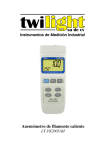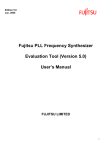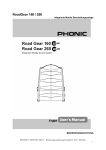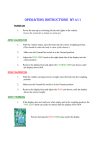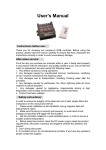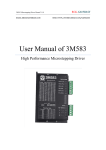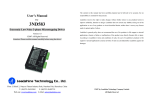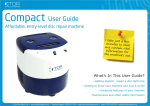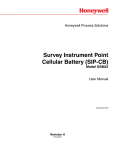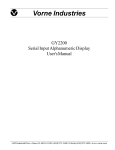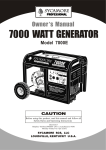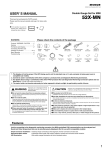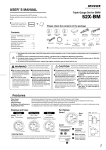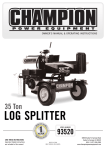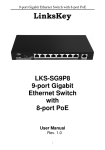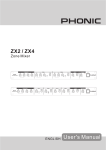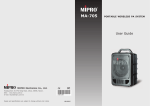Download Road Gear 160 Road Gear 260
Transcript
Road Gear 160 Road Gear 260 Integrated Mobile Sound System PLUS PLUS IMPORTANT SAFETY INSTRUCTIONS The apparatus shall not be exposed to dripping or splashing and that no objects with liquids, such as vases, shall be placed on the apparatus. The MAINS plug is used as the disconnect device, the disconnect device shall remain readily operable. Warning: the user shall not place this apparatus in the can be easily accessible. area during the operation so that the mains switch 1. Read these instructions before operating this apparatus. CAUTION 2. Keep these instructions for future reference. RISK OF ELECTRIC SHOCK DO NOT OPEN 3. Heed all warnings to ensure safe operation. 4. Follow all instructions provided in this document. 5. Do not use this apparatus near water or in locations where condensation may occur. 6. Clean only with dry cloth. Do not use aerosol or liquid cleaners. Unplug this apparatus before cleaning. 7. Do not block any of the ventilation openings. Install in accordance with the manufacturer’s instructions. 8. Do not install near any heat sources such as radiators, heat registers, stoves, or other apparatus (including . 9. Do not defeat the safety purpose of the polarized or grounding-type plug. A polarized plug has two blades with one wider than the other. A grounding type plug has two blades and a third grounding prong. The wide blade or the third prong is provided for your safety. If the provided plug does not into your outlet, consult an electrician for replacement of the obsolete outlet. 10. Protect the power cord from being walked on or pinched particularly at plug, convenience receptacles, and the point where they exit from the apparatus. 11. Only use attachments/accessories manufacturer. by the 12. Use only with a cart, stand, tripod, bracket, or table by the manufacturer, or sold with the apparatus. When a cart is used, use caution when moving the cart/apparatus combination to avoid injury from tipover. 13. Unplug this apparatus during lighting storms or when unused for long periods of time. 14. Refer all servicing to service personnel. Servicing is required when the apparatus has been damaged in any way, such as power-supply cord or plug is damaged, liquid has been spilled or objects have fallen into the apparatus, the apparatus has been exposed to rain or moisture, does not operate normally, or has been dropped. CAUTION: TO REDUCE THE RISK OF ELECTRIC SHOCK, DO NOT REMOVE COVER (OR BACK) NO USER SERVICEABLE PARTS INSIDE REFER SERVICING TO QUALIFIED PERSONNEL The lightning flash with arrowhead symbol, within an equilateral triangle, is intended to alert the user to the presence of uninsulated “dangerous voltage” within the product’ magnitude to constitute a risk of electric shock to persons. The exclamation point within an equilateral triangle is intended to alert the user to the presence of important operating and maintenance (servicing) instructions in the literature accompanying the appliance. WARNING: To reduce the risk of or electric shock, do not expose this apparatus to rain or moisture. CAUTION: Use of controls or adjustments or performance of procedures other than those may result in hazardous radiation exposure. Road Gear 160 Plus Road Gear 260 Plus Integrated Mobile Sound System Introduction....................................................................................................................4 Features........................................................................................................................4 RoadGear Components................................................................................................5 Dissembling the Road Gear...........................................................................................6 Initial Setup....................................................................................................................6 The RoadGear Mixer.....................................................................................................7 Making a Connection............................................................................................. 7 Controls and Settings ............................................................................................8 Digital Effects (RoadGear 160 Plus) .....................................................................8 Digital Effects Panel (RoadGear 260 Plus)............................................................9 Master Controls .....................................................................................................9 Rear Panel ...........................................................................................................10 Combination Docking Lock..........................................................................................11 The RoadGear Speakers............................................................................................12 Microphone .................................................................................................................12 Optional RoadGear Accessories ................................................................................12 On The Road Application.............................................................................................14 Specifications..............................................................................................................15 Block Diagrams...........................................................................................................16 Phonic preserves the right to improve or alter any information within this document without prior notice. V1.0 Nov 06th,2006 Introduction Features We at Phonic would like to congratulate you on purchasing one of the RoadGear Plus mobile audio systems, a set of audio equipment superior in design and versatility. The Phonic RoadGear sets allow you to take all the equipment you need to setup an advanced all-in-one integrated sound system anywhere you go, with a minimum of fuss. The fully self-contained unit includes two full-range speakers, a powered mixer, and two dynamic microphones, as well as all the needed cables. RoadGear also gives you the option of using wireless microphones and supplies enough storage space to pack them conveniently away. Common Features Setting up the RoadGear couldn’t be easier. Just release the docking lock, and, after disassembling the mobile kit, simply position the speakers, and plug them, the microphone, and any other instruments or devices you wish, into the powered mixer. After plugging the powered mixer into an appropriate power supply, your system is ready to use. Not only is it this simple to set up, however, but using the system is just as simple. Using the controls of the supplied powered mixer, simply adjust the levels of the inputs, as well as the high, low, and middle frequencies of the inputs, and the digital effects processor. All these features make the RoadGear an easy and convenient solution to a mobile sound system. This user’s manual is specifically designed to give you accurate information on the function and use of the RoadGear 160 Plus and RoadGear 260 Plus. After thoroughly reading this manual, it is suggested you store it in an easily accessible place for future reference. Integrated mobile sound system with luxury luggage-style molded cabinet plus wheels Operates on AC or DC power Speaker system with 1” compression driver and 8” woofer 2-band EQ on each input channel Two 30 feet speaker cables Two receiver slots for optional wireless microphones Storage compartment for microphones, cables and accessories RoadGear 160 Plus additional features 160 Watt (80 per channel) stereo Four input channel mixer: three mic/line and one stereo Echo effect with delay time and repeat controls System equalizer with treble/bass control One dynamic microphone (with mic clip, cable and carry pouch) RoadGear 260 Plus additional features 260 Watt (130 per channel) stereo Six input channel mixer: four mic/line, two stereo High-Definition digital effect processor with 16 programs and tap-delay 3-band system equalizer Two dynamic microphones (with clips, cables and individual pouches) RoadGear160/260 Plus RoadGear Components Caution RoadGear 160 Plus Use the AC power cable supplied with the RoadGear sets only When buying the RoadGear, the AC power cable will be specific to the safety and code requirements of the Country of purchase The ground (earth) pin of the AC power cable’s male connector should under no circumstances be removed. When taking the RoadGear abroad, check local voltage levels and ensure the appropriate power standard is used, as selected by the power selection switch on the rear panel. When the RoadGear is in use, the storage compartment door much be kept open for better ventilation Two Speakers with specially molded enclosures One powered mixer built into a specially molded storage case One Phonic UM 99 microphone with 20 foot (6 meter) cable, clip and carry pouch Two 30 foot (9 meter) speaker cables Detatchable power cable One transparent dust cover RoadGear 260 Plus Two Speakers with specially molded enclosures One powered mixer built into a specially molded storage case Two Phonic UM 99 microphones each with 20 foot (6 meter) cable, clip and carry pouch Two 30 foot (9 meter) speaker cables Detatchable power cable One transparent dust cover RoadGear160/260 Plus RoadGear160/260 Plus The RoadGear Mixer The powered mixer provided with the RoadGear 260 Plus is equipped with 4 mono microphone and line inputs, as well as 2 stereo inputs and a built in effect processor boasting a 32/40-bit DSP. All this, plus a 3-band built in equalizer, ensures your audio always sounds great on the road. The RoadGear 160 Plus’s mixer is equipped with 3 mono mic and line inputs, a single stereo channel, built-in digital echo and system bass/treble control. 4. Stereo AUX Return These TS inputs connect the mixer with parallel external devices, such as sub mixers or external effect processors, receiving the processed signal from another source and feed it to the main mixing bus. If you wish to use a signal from a mono device, simply connect the input to the left jack, and the signal will be doubled to the right, effectively making it a mono signal. 5. Record Out These outputs will accommodate RCA cables to be fed to a variety of recording devices, such as tape and digital recorders. Making a Connection 4 7 5 3 RoadGear260 4 6 RoadGear160 1. Microphone Input Jacks These XLR jacks are for the input of low level signal devices, most commonly, microphones. For best performance, we suggest using the microphones supplied with the RoadGear set, however they can be used in conjunction with any professional condenser, dynamic (RoadGear 260 Plus only) or ribbon microphones with standard 3-pin XLR male connectors. 2. Line Input Jack These 1/4” TS phone jacks accept a wide range of input line level devices, such as guitars and keyboards. It can accept unbalanced sources, however any microphones plugged into the microphone input will not work when a line device is attached to this system. 3. Stereo Inputs The stereo inputs include 2 sets of jacks: standard RCA stereo jacks, for use with consumer gear like CD and tape players, etc., and stereo 1/4” TS phone jacks, for use with stereo products such as keyboards and drum machines. The RCA and TS jacks can both be used simultaneously; however, in some cases this is unadvisable as the blending of audio may have undesirable results. The audio fed into these input are fed to the corresponding stereo input bus. RoadGear160/260 Plus 6 6. Effects (EFX) Out These 1/4” TS outputs are the final output from the effects send mixing bus. This feed may be used to connect to an amplifier and speakers, or to external digital effect processors. When using external processors, the feed can be returned to the Stereo AUX Return ports. 7. Foot Switch (RoadGear 260 Plus only) This port allows the inclusion of a foot switch for remote alteration of digital effect properties (on or off). The upper one is for turning on and off effect; the lower one is for changing tap delay. 8. Send and Return (RoadGear 260 Plus) These connectors allow external signal processors to be incorporated with the main mix, just prior to being sent through the power amplifier. Devices that can be used in conjunction with these jacks include graphic equalizers, digital effect processors, feedback silencers, and so forth. It is strongly advised that these devices are set at low levels to ensure the RoadGear’s inputs do not overload. 8 9. Speaker Outputs 13. PAN / BAL Control These jacks are used to connect to speakers, fed from the internal power amplifier. Both sets of outputs are 1/4” TS jacks, which can drive 130 Watts of output into 8Ω (or 80 Watts into 8Ω on the RoadGear 160 Plus) per channel. To use these, simply insert an appropriate 1/4” TS plug into them. The RoadGear 260 Plus features 2 speaker outputs per channel, whereas the RoadGear 160 Plus features a single output per channel. The ‘pan’ control alternates the degree or level of the mono audio signal that the left and right channels of the main mix should receive. On stereo channels, the ‘Balance’ attenuates the left or right signal as required. NB. Due to the fact that the output signal of these jacks is active, they should be used in conjunction with speakers only as to avoid damaging any other equipment. 9 This control alters the signal level of the corresponding channel to the main mix of the RoadGear. This control should be set at “0” when the mixer is not in use. Digital Effects (RoadGear 160 Plus) 9 RoadGear 160 Plus 14. Level Control RoadGear260 Plus Controls and Settings 15 10. High Frequency Control This control alters the degree of high frequencies – or treble – in the audio of the corresponding channel. Turn clockwise to increase the 10 amount of treble in the sound, and turn counterclockwise to decrease the amount. Position 11 the knob for a flat response, if not in use. 11. Low Frequency Control This control alters the degree of high frequencies – or bass – in the audio of the corresponding channel. Turn clockwise to increase the amount of bass in the sound, and turn counterclockwise to decrease the amount. Position the knob at “0” if not in use. 12 13 16 17 15. Time Control This control adjusts the time of the built-in echo effect. 16. Repeat Control This control adjusts the frequency of the repeats in the Echo effect. 17. Level Control This control adjusts the amount of the audio from the built-in Echo effect processor that will be sent to the main mix. 14 12. MONI / EFX Control This control adjusts the signal level of the corresponding channel to be sent to the EFX and Monitor mixing bus, for digital effect processing and monitoring of audio, respectively. RoadGear160/260 Plus Digital Effects Panel (RoadGear 260 Plus) 19 22 18 20 21. EFX Master Control The EFX master control adjusts the final level of the processed signal that is sent to the main mix. 22. Bypass Switch Pushing this switch will bypass the effect engine. Two small indicators within the Effects display will flash when this is done. 21 Master Controls 18. Digital Effects Panel This 2-digital numeric display shows the program number that is currently applied to your EFX audio signal. When you rotate the Program control, you can scroll through different program numbers; however the display will revert back to the original program if a new program is not selected within a few seconds. 19. Sig and Clip Indicators Located within the Digital Effect Display are Clip and Sig LEDs. The Sig LED will light up when any signal is received by the effect processor, and the Clip LED will light up shortly before excessive signals are dynamically clipped. If the Clip LED lights up too often, it may be advisable to turn down one or all EFX controls on input channels to ensure the signal level is not too high. 20. Program Control This control is used to scroll through the various effects. Turning the control clockwise will allow users to ascend into higher program numbers, and turning it counter-clockwise will allow users to descend into lower program numbers. Pushing this control will apply the new effect. When a tap-delay effect is selected, pressing this control will allow users to select the tap-delay time. By pushing the button several times, the effect processor interprets the time between last two pushes and remembers this as the delay time, until the button is pushed again (this is kept, even after the power is turned off). When the tap delay effect is selected, a small LED will flash within the digital effect display window at the selected intervals. RoadGear160/260 Plus 23 23. System Equalizer The RoadGear 260 Plus’s built in equalizer provides you with 3 different level controls, for perfect control over the high, mid and low frequencies of your audio. Changing the level of high frequencies included in your audio with enhance the treble sounds, such as guitars, as well as enhancing the crispness of vocals. Changing the level of low frequencies in your audio will enhance bass sounds, including drums and bass guitars, and add to the overall warmth of the sound. Changing middle frequencies can help add crispness to vocals. The RoadGear 160 Plus features a single bass / treble control for adjusting the high and low frequency balance of your mix. 24. L/R Level Controls These controls are used to adjust the final volume level of the MAIN Left and Right signal, sent to the power amplifier and respective outputs (as set by the mode selector switch). 24 25. Limiter Indicators There are 2 limiters built-in the stereo power amplifier featured in the RoadGear 160 Plus and 260 Plus. The limiters will kick into action (and these LEDs illuminate) when the signal levels become excessive. The limiter system will help prevent any damage from occurring to any of your equipment, as well as try to maintain signal clarity. However, if these LEDs are lighting up, it is advisable to turn the main level controls. 25 Rear Panel 29. DC Power Supply Input This DC power input is used to connect the RoadGear 12VDC-to-48VDC converter (and portable 12V battery) to the RoadGear, enabling you to use the RoadGear system when an AC power source is unavailable. The rightmost socket is used for the positive connection, and the leftmost is used for the negative. The two middle sockets are used for grounding. The power supply used should not exceed 51VDC as to ensure safe operation of the RoadGear. 26 29 30. Power Connector and Fuse Holder 26. Mode Selector This is used to alternate the use of the power amplifier outputs. If stage monitors are used in your set of speakers, then the switch can be set to the MAIN / MONI position. On the RoadGear 260 Plus, this will allow you to plug main speakers into the LEFT / MAIN speaker outputs, and a set of passive monitors (with an impedance of 8Ω or above) to the RIGHT / MONI outputs. On the RoadGear 160 Plus, this selection will cause the left speaker output to send the main signal (in mono); the right speaker output will send the monitor signal. When set to LEFT / RIGHT, the speaker outputs send the main left and right signals as normal. 27. +48V Switch (RoadGear 260 Plus only) This switch supplies +48V of phantom power to all input channels, used for powering condenser microphones. 28. Power Switch This button is used to turn the device on and off. This port is used to plug the female end of the included AC power cable. The other end should be connected to an appropriate power source. Just below this connector is the RoadGear’s fuse holder. In the event that the fuse blows, users can open this holder, remove the old fuse and replace it with another suitable fuse (listed near the power connector). 31. Voltage Selector The Voltage Select switch is used to adapt the RoadGear to different Countries’ voltage levels. You are able to select between 115V (which you can use in Countries with standard voltage between 100V and 120V) and 230V (which can be used in Countries with standard voltage between 220V and 240V). 27 30 31 28 10 RoadGear160/260 Plus 32. Wireless Module Slots Located conveniently within the RoadGear storage compartment, these two slots accept the UMR11 wireless receiver module (available with the UM31, UM41 and UM51 wireless microphone kits). The wireless signal received by the left slot is sent to channel 2 of the RoadGear mixer, whereas the right slot is sent to channel 1. Combination Docking Lock The docking locks of the RoadGear are combination locks, which require the user to enter a preset combination to open them. Please observe the following instructions to opening the lock. 1) The default code of the lock is 000. Please enter this code the first time you use the RoadGear. 2) To change the lock’s code, first open the latch and find a small lever on the underneath of the lock. Pull it towards the center of the lock, and up, until it sticks into place. 3) Change the number dials to your desired secret code. Ensure you either remember the code or write it down somewhere, as to not have to attempt to break the RoadGear apart in a way that would not be favorable to it whatsoever. 4) After entering your desired code, replace the small lever underneath the lock into its original position and voila! Your new, secret code is set. This process must be repeated for each lock separately. It’s advised that you have the same code for each lock, as to avoid confusion. 32 33. Storage Compartment Latch This small latch keeps the storage compartment closed when not in use. Flick it up before opening, and be sure not to force open the storage compartment as to avoid damaging this latch. 33 RoadGear160/260 Plus 11 Optional RoadGear Accessories The RoadGear Speakers The specially molded speakers that are included in both sets provide 8 inch woofers, as well as a 1” compression driver for high quality sound reproduction. Included with the speakers are two 30 foot speaker cables. Each speaker has an impedance of 8Ω. It is important that users do not pick the RoadGear up by the latches that hold it in place when the kit is assembled. Doing so can cause damage to the latches, making them useless. Furthermore, when using the speakers, be sure to lock the latches at the lower-rear end of the speaker back into place. This also avoids damaging the latch. In addition to all this, the RoadGear sets provide you with the option of using various added features. Wireless microphones, with 2 module inputs conveniently placed at the rear of the mixer, are a fantastic way to ensure the microphone cord is never in the way. Dual and single speaker stands compatible with the RoadGear speakers enable you to position your speakers in a way that best suits your setting, for a greater dispersion of audio. The optional battery packs provide power to the RoadGear sets when no other power source is around. These just add to the ease and convenience that RoadGear provides. The following is a list of all optional accessories: CV-RG: RoadGear 12V DC-DC power converter. BP-RG: RoadGear Battery pack. TB-RG: RoadGear Travel bag, used to protect the RoadGear during transportation or in storage. MK1-RG: RoadGear Speaker wall mount kit. MK2-RG: RoadGear Dual Speaker Mount, allow you to mount two RoadGear speakers at one tripod stand. Microphone Included with the RoadGear sets will be a microphone (two with the RoadGear 260 Plus), more specifically the Phonic UM99 microphone. The Phonic UM99 will no doubt supply you with a fantastically refined sound for use in public addresses or even for vocals in live performances. Polar Pattern: Cardioid (unidirectional) SK1: Two Speaker Stands, including carry bag. SK2: Two Mic Stands & two Speaker Stands, including carry bag. BG-RG: RoadGear DC power accessory bag, can handle battery pack and DC to DC converter, as well as some cables. Frequency Response: 50 Hz – 15 kHz Impedance: 600Ω ± 30% (at 1000 Hz) Sensitivity: -72dB ± 3 dB (SPL = 74 dB, 0 dB = 1V/μ bar; at 1000 Hz indicated by open circuit) Switch: on & off Dynamic Microphone Cartridge: CUM-112 (copper voice coil) Mechanical Spec: Dimensions: Ø52 x 178 mm Weight: 232g (without cable) UM99 12 RoadGear160/260 Plus Wireless Microphone Battery Pack There are 3 different wireless microphone kits available for the RoadGear mobile audio systems: the UM31, UM41 and UM51. Each of these systems provides users with the same wireless receiver, however includes either a handheld, lavaliere or headset microphone. The BP-RG Battery Pack and CV-RG 12 volt DC-to-DC converter can be used to power the RoadGear in areas where no AC power supply is available. The battery pack should provide up to 4 hours of continuous use, and is rechargeable. UM31 Handheld System Handheld transmitter (HT-100) Wireless receiver module (UM-R11) UM41 Lavaliere System Lavaliere microphone (ML-10) Bodypack transmitter (BT-200) Wireless receiver module (UM-R11) UM51 Headset System Headset microphone (MH-20) Bodypack transmitter (BT-200) Wireless receiver module (UM-R11) RF Frequency Oscillation Type Channels Frequency Response Bandwidth Operation Range Model Number Charge Time Battery Time Lighting Time Dimensions (W x H x D) Weight BP-RG Battery pack 30 hours 4 hours Up to 25 hours 226 x 325 x 99 mm 8.9” x 12.8” x 3.9” 7.75 kg (17.1 lbs) Model Number CV-RG DC to DC converter 12V nominal +48VDC and -48VDC 40 amp 10 amp 100 x 50 x 166 mm 3.9” x 2.0” x 6.5” 1.27 kg (2.8 lbs) Input Voltage Output Voltage Input Fuse Output Fuse Dimensions (W x H x D) Weight 614 – 870 MHz PLL Synthesized Control Oscillation 16 Channels 50 Hz – 18 kHz, +/-3dB 2 3 24 MHz 100m 1 OFF 4 ON RoadGear160/260 Plus 13 On The Road Application The Phonic RoadGear sets are use the same was as an ordinary PA system would be, but with the convenience of having all the components in one handy package, and as such has the potential to be set up in a variety different ways. Below is just one of the many possible examples we could have given you in setting up the gear, hopefully giving you a good idea of the amazing possibilities that RoadGear provides. MIC DRUM MACHINE MIC GUITAR CD PLAYERS SIGNAL PROCESSOR SIGNAL PROCESSOR RoadGear260 Plus only KEYBOARD, SYSNTHESIZER, SAMPLER ROADGEAR SPEAKERS FOOT SWITCH RoadGear260 Plus only 14 RoadGear160/260 Plus Specifications RoadGear 160 Plus RoadGear 260 Plus Drivers Compression tweeter & 8" woofer Compression tweeter & 8" woofer Stand Adapter 35mm 35mm Output Power 2 x 80W @ 8 ohms 2 x 130W @ 8 ohms Mid/High Crossover Point 2 kHz 2 kHz Speakers Mixer Channels 3 mono & 1 stereo CH, 2-band EQ, Efx send, pan, level 4 mono & 2 stereo CH, 2-band EQ, Efx send, pan, level Mono Channel Balanced, XLR & 1/4" TRS Balanced, XLR & 1/4" TRS Stereo Channel 2 x 1/4" TS & 2 x RCA 2 x 1/4" TS & 2 x RCA Multi-effect Processor Echo with time and repeat control 16 programs plus tap delay, 40-bit Foot Switch na Momentary, Effect On / Mute and tap System EQ Treble/Bass 3-band Minimum Impedance of Power Amplifier Amp Mode 8 ohms 4 ohms L & R or MAIN & MONITOR, with limiter indicators Speaker Out L & R or MAIN & MONITOR, with limiter indicators 1 x 1/4" TS per channel Tape Out One Stereo RCA One Stereo RCA EFX Out & ST Return Yes, 1/4" TS Yes, 1/4" TS Phantom Power na Yes Wireless Mic Module Socket 2 x 1/4" TS per channel with insert Send and Return 2 (wireless microphones and receiver 2 (wireless microphones and receiver modules are optional) modules are optional) Miscellaneous 1 x Phonic UM99 microphone with clip, 20' cable, and carry pouch 2 x 30' speaker cables 2 x Phonic UM99 microphone with clip, 20' cable, and carry pouch 2 x 30' speaker cables 1 x detachable power cable 1 x detachable power cable 1 x PVC dust cover 1 x PVC dust cover Power Requirement Switchable between 115VAC / 60Hz and 230VAC / 50Hz, or optional Switchable between 115VAC / 60Hz and 230VAC / 50Hz, or optional Dimensions (H x W x D) 818 x 635 x 352 mm (32.2" x 25" x 13.9") 818 x 635 x 352 mm (32.2" x 25" x 13.9") Net Weight 27 Kg (59.5 lbs) 28 Kg (61.7 lbs) Included Accessories RoadGear160/260 Plus 15 AUX_RTN/R INPUT AUX_RTN/L INPUT AUX_RTN INPUT TAPE/R INPUT TAPE/L INPUT ST/R INPUT ST/L INPUT(MONO) ST INPUT LINE(Balance) Pre/amp TIME REPEAT DIGITAL EFX PROCESSOR + + - + HIGH LOW LEVEL 2 BAND TONE LOW 2 BAND TONE HIGH 2 BAND TONE VOL EFX/ MONI BAL EFX/ MONI PAN MAIL_L MAIL_L CH1_3 INPUT MIC(Balance) EFX EFX WIRE LESS MODULE MONI MONI 16 MAIN_R MAIN_R CHANNEL 1&2 USE MONO RIGHT MAIN LEFT MASTER R MASTER L BASS BASS TREBLE TREBLE REC _R EQ EQ REC _L LIMIT R LED LIMIT L LED R/AMP. MODULE L/AMP. MODULE EFX OUT CROSS_OVER CROSS_OVER SPEAKER R OUT SPEAKER L OUT Block Diagrams RoadGear160 Plus RoadGear160/260 Plus RoadGear160/260 Plus TAP ON /OFF FOOT SW AUX_RTN/R INPUT AUX_RTN/L INPUT AUX_RTN INPUT TAPE/R INPUT TAPE/L INPUT ST/R INPUT ST/L INPUT(MONO) + + + - SIG CLIP B Y PA SS DIGITAL EFX PROCESSOR PR O G R AM Pre/amp ST1_2 INPUT LINE(Balance) MIC(Balance) HIGH LO W E FX MA S TE R 2 BAND TONE LOW 2 BAND TON E HI G H 2 B AND TON E LEV EL LEVEL EFX/ MONI BAL EFX/ MONI PAN E FX EFX CH1_4 INPUT MONI MONI MAIL_L MAIL_L WIRE LESS MODULE MAIN_R MAIN_R CHANNEL 1&2 USE MONO RIGHT MAIN LEFT AMP RTN R AMP RTN L MA S T ER R M AST E R L REC _R LIMIT LED LIMIT LED HIGH 3 B AND T ON E LO W LO W M ID M ID HIGH 3 B A N D T O NE REC _L R/AMP. MODULE L/A MP. MODULE PROT. PROT. CROSS_OVER CROSS_OVER EFX OUT MINI LOAD 8/Ohm SPEAKER R OUT MINI LOAD 8/Ohm SPEAKER R OUT MINI LOAD 8/Ohm SPEAKER L OUT MINI LOAD 8/Ohm SPEAKER L OUT SEND R S EN D L RoadGear 260 Plus 17




















